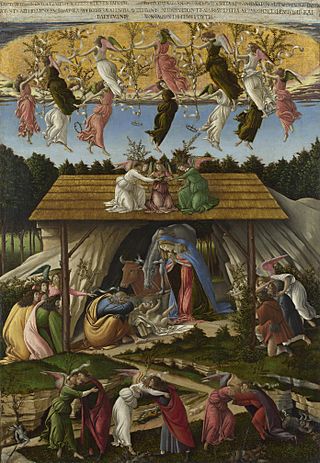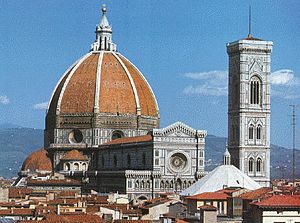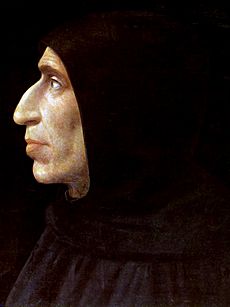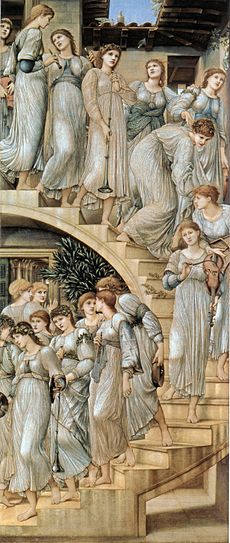The Mystical Nativity facts for kids
Quick facts for kids The Mystical Nativity |
|
|---|---|
 |
|
| Artist | Sandro Botticelli |
| Year | c. 1500–1501 |
| Medium | Oil on canvas |
| Dimensions | 108.5 cm × 74.9 cm (42.7 in × 29.5 in) |
| Location | National Gallery, London |
The Mystical Nativity is a famous painting by the Italian artist Sandro Botticelli. He painted it around 1500–1501 using oil on canvas. Today, you can see it at the National Gallery in London. This painting is special because it's the only one Botticelli ever signed. It also shows the birth of Jesus in a very unusual way.
At the top of the painting, there's a message written in Greek. It says that Botticelli painted this picture at the end of the year 1500, during difficult times in Italy. He believed he was living through a period of great trouble, like those described in the Book of Revelation in the Bible. He thought that after a time of chaos, good would win, and we would see peace, just like in his painting. Botticelli might have felt this way because of all the big changes happening in Europe back then.
Some people think this painting was influenced by Girolamo Savonarola. He was a powerful preacher whose ideas appeared in many of Botticelli's later works. The painting also uses an old art trick: it makes the Virgin Mary and baby Jesus look bigger than other people and their surroundings. Botticelli did this on purpose, even though he knew how to paint things with correct perspective.
Don't mix this painting up with another one called Mystical Nativity or Adoration in the Forest by Filippo Lippi. That one is in Berlin.
What the Painting Shows
In the middle of the painting, the Virgin Mary is kneeling in front of the Christ Child. Both Mary and Jesus are painted larger than the other figures. Saint Joseph sits on the ground next to the child, perhaps sleeping, and you can't see his face. Behind the family, there's an ox and a donkey.
On each side of Mary, Joseph, and Jesus, an angel holds out an olive branch. These angels are showing the child to two shepherds on one side and three men in long robes on the other. These three men might be the biblical Magi. All five of these people are kneeling and have olive branches on their heads.
At the bottom of the painting, three angels are hugging three men, who also have olive branches on their heads. Around them, seven small devils are hurting themselves with spears and falling into the ground. It looks like they are "burying themselves."
Why Botticelli Painted It
The Mystical Nativity shows a happy and joyful scene. Angels are dancing at the top, celebrating. But Botticelli also included some serious messages. The helpless baby Jesus rests on a cloth that looks like the shroud he would be wrapped in after his death. The cave where the scene takes place also reminds us of a tomb.
At the top, twelve angels dance in a circle. They are dressed in colors that stand for faith, hope, and charity (love). They hold olive branches. Above them, heaven opens up in a big golden dome. At the bottom, three angels hug three men, lifting them up. They hold scrolls that say in Latin, "peace on earth to men of goodwill." Behind them, seven devils run away, some stuck on their own weapons.
In Botticelli's time, paintings about the Last Judgment showed people who were saved and people who were not. Art expert Jonathan Nelson says that The Mystical Nativity makes us think not only about Jesus's birth but also about his return.
This painting was created in Florence, Italy, during a time when a very strict preacher named Girolamo Savonarola had a lot of power. He arrived in Florence in 1490 and didn't like how rich and artistic the city was. He preached that Florence was full of sin and that bad things would happen.
His words seemed to come true when a large French army invaded Italy in 1494. Ten thousand soldiers entered Florence, and people worried the city would be destroyed. Savonarola stepped in and convinced the French king to leave Florence peacefully. Because of this, many Florentines saw him as a prophet. Huge crowds came to hear him preach at Florence Cathedral.
Savonarola said that Florence could become a new Jerusalem if people stopped their sinful ways and gave up their fancy things. This included much of their art. Young people went into the streets to encourage others to get rid of their luxuries, books, and mirrors. Botticelli might have even seen his own paintings burned in bonfires. But he might not have minded, because like many people in Florence, he was influenced by Savonarola.
It seems that one of Savonarola's sermons directly inspired The Mystical Nativity.

In one sermon, Savonarola described a vision he had. He saw a special heavenly crown with twelve hearts at its base. On ribbons wrapped around these hearts were twelve special qualities of the Virgin Mary. Even though much of the writing on the angels' ribbons in the painting is now hard to see, special infrared cameras have shown that the original words match Savonarola's twelve qualities of Mary exactly.
In that same sermon, preached on Assumption Day, Savonarola talked about chapters 11 and 12 of the Book of Revelation. These are the exact chapters mentioned in the painting's inscription. He connected Mary's glory with the idea that Christ's power would soon come to Earth.

Savonarola controlled Florence for years, but his strict rule made him powerful enemies. He was challenged to prove his holiness by walking through fire. When he refused, people turned against him. On May 23, 1498, he was executed with two of his main helpers. Some people think the three men at the bottom of the painting represent these three executed holy men, brought back to grace. But Savonarola's followers faced hard times, and it was in this difficult atmosphere that Botticelli created The Mystical Nativity.
How It Was Made
Botticelli painted The Mystical Nativity on canvas, which was unusual for him. He usually used wood panels. Perhaps canvas was better for a painting with a risky message, as it could be rolled up and hidden.
First, he would draw a detailed design on paper. Then, he would transfer this design onto the canvas. He got ideas from many places. The dancing angels look like the three graces in his own painting Primavera. The running devil was inspired by a German woodcut. X-rays show that Botticelli changed very little from his first design. He only adjusted an angel's wing and added trees over the stable roof.
Botticelli then used tempera paint to build up the image. Using canvas was still an experiment for artists at that time. To create the heavenly dome, Botticelli used skills he learned as a boy working with goldsmiths. Gold was used to show that heaven is unchanging and perfect, because gold doesn't decay or darken. Botticelli would have pressed gold leaf onto the canvas, making it glitter and sparkle. This would have made the painting look like a jewel and drawn the viewer's eye up towards heaven. The angels are dressed in white, green, and red for faith, hope, and charity. However, the green paint, which contained copper, has changed color over time to a bronze shade. Originally, it would have been a bright, lively green.
Later On
Botticelli died in 1510. The Mystical Nativity wasn't well-known for about 300 years after that. At the end of the 1700s, a wealthy Englishman named William Young Ottley was in Rome. He loved art and bought many paintings cheaply. At a place called the Villa Aldobrandini, he found Botticelli's Mystical Nativity, which was then a small, unknown work. Botticelli himself was not famous at this time.
The painting came to London, where Ottley's house became like a private museum of Italian masterpieces. After Ottley died, William Fuller Maitland bought the painting at an auction for £80. When he lent it to the Art Treasures Exhibition, Manchester 1857, many people probably saw it for the first time. A newspaper for the exhibition even printed a picture of it.
After the painting was shown in Manchester, people's opinions about Botticelli's art really changed. By the late 1870s and 1880s, Botticelli became very popular. Artists who wanted to be modern looked to his work. For example, Dante Gabriel Rossetti and Edward Burne-Jones both used ideas from The Mystical Nativity in their own art. Burne-Jones even copied some of Botticelli's drawings for Dante's Divine Comedy into his sketchbooks. Rossetti showed his love for Botticelli's work by buying his portrait of Smeralda Bandinelli in 1867.

John Ruskin, a famous art critic, helped give the painting its name. After seeing it in London, he talked about Botticelli's "mystic symbolism." When Maitland died in 1876, the National Gallery in London decided to buy the painting. According to Nicholas Penny, the Gallery wanted to buy older Renaissance artworks. Buying paintings like this was exciting and new for a museum in the 1800s. When the Gallery bought the painting in 1878, they paid £1,500. This was almost 20 times more than it had sold for just thirty years earlier!
|
See also
 In Spanish: Natividad mística para niños
In Spanish: Natividad mística para niños

